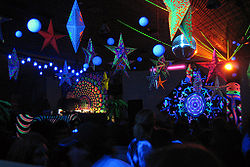History

Origins
The first hippies who arrived in Goa, India (a former Portuguese colony) [6] in the mid-1960s were drawn there for many reasons, including the beaches, the low cost of living, the friendly locals, the Indian religious and spiritual practices and the readily available Indian cannabis, which, until the mid-1970s, was legal. [7] During the 1970s, the first Goa DJs were generally playing psychedelic rock bands such as the Grateful Dead, Pink Floyd and The Doors. In 1979, the beginnings of electronic dance music could occasionally be heard in Goa in the form of tracks by artists such as Kraftwerk, but it was not until 1983 that DJs Laurent and Fred Disko, closely followed by Goa Gil, began switching the Goa style over to electro-industrial/EBM which was now flooding out of Europe from artists such as Front 242 and Nitzer Ebb as well as Eurobeat. [8] [9]
The tracks were remixed, removing the lyrics, looping the melodies and beats and generally manipulating the sounds in all manner of ways before the tracks were finally presented to the dancers as custom Goa-style mixes. [10]

By 1990–91, Goa was beginning to attract attention and had become a popular destination for partying. As the scene grew bigger, Goa-style parties spread like a diaspora all over the world from 1993. Parties like Pangaea and Megatripolis in the UK helped spawn a multitude of labels in various countries (U.K., Australia, Japan, Germany and Israel) to promote psychedelic electronic music that reflected the ethos of Goa parties, Goa music, and Goa-specific artists, producers, and DJs. [11] Goa Trance as a commercial scene began gaining global traction in 1994. The golden age of the first wave of Goa psy trance as a generally agreed upon genre[ according to whom? ] was between 1994 and 1997.
Development

By 1992, the Goa trance scene had established an independent dynamic, though the term "Goa trance" did not become the characterization of the genre until around 1994. [12] The Goa trance sound, which, by the late 1990s, was being used interchangeably with the term psychedelic trance, retained its popularity at outdoor raves and festivals,[ citation needed ] but also permanent psytrance nightclubs emerged such as Natraj Temple in Munich. [4] New artists were appearing from all over the world and it was in this year that the first Goa trance festivals began, including the Gaia Festival in France and the still-running VooV festival in Germany.
In 1993, the first Goa trance album was released, Project II Trance, featuring tracks by Man With No Name and Hallucinogen, to name two. Goa trance enjoyed its commercial peak between 1996 and 1997 with media attention and some recognized names in the DJ scene joining the movement. This hype did not last long and once the attention had died down, so did the music sales, resulting in the failure of record labels, promotion networks and also some artists. This "commercial death of Goa trance" was marked musically by Matsuri Productions in 1997 with the release of the compilation Let it RIP. On the back sleeve of the album at the bottom of the notes, “R.I.P : Mother Theresa, Princess Diana, William Burroughs & Goa Trance” was written.
While the psytrance genre began in the Goa trance scene, it went on to proliferate globally. [13] Its impact was felt in western Europe, Middle East, North America, Australia, Japan and South Africa. [13] Psytrance is linked to other music genres such as big beat, electroclash, grime and 2-step. [14] The genre evolved in conjunction with the multimedia psychedelic arts scene. [13]
